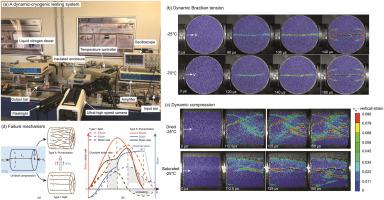当前位置:
X-MOL 学术
›
Int. J. Rock Mech. Min. Sci.
›
论文详情
Our official English website, www.x-mol.net, welcomes your feedback! (Note: you will need to create a separate account there.)
Dynamic mechanical behaviours of frozen rock under sub-zero temperatures and dynamic loads
International Journal of Rock Mechanics and Mining Sciences ( IF 7.0 ) Pub Date : 2024-06-22 , DOI: 10.1016/j.ijrmms.2024.105813 Kai Liu , Tingting Wang
International Journal of Rock Mechanics and Mining Sciences ( IF 7.0 ) Pub Date : 2024-06-22 , DOI: 10.1016/j.ijrmms.2024.105813 Kai Liu , Tingting Wang

|
Dynamic mechanical behaviours of frozen rocks are essential for dealing with the design and stability of various engineering structures in cold regions. A dynamic-cryogenic testing system integrated with high-speed Digital Image Correlation (DIC) is adopted to investigate the dynamic mechanical behaviours of rock subjected to ambient room and sub-zero temperatures, along with high-rate loading. Dynamic compression, tensile and Mode I dynamic fracture tests were performed at 20, -20, −50 and −70 °C using dry and saturated sandstone from Yulong Copper Mine at high-altitude cold region. A DIC-based approach using pixel-based virtual extensometers is proposed to accurately capture the real-time cracking speed with high precision. The proportion of ice and unfrozen water in rock pores across various temperatures is quantified using the nuclear magnetic resonance (NMR) method. The results indicate significant temperature and rate dependencies in dynamic fracture toughness, crack propagation velocity, dynamic tensile strength, dynamic compressive strength, and failure modes; These parameters exhibit an increase with decreasing ambient temperature as unfrozen water transitions into ice, demonstrating the frozen effect of ice filling pores, supporting the rock skeleton, and bonding ice-rock interfaces. With decreasing temperature, crack branching becomes more pronounced in dynamic notched semi-circular bending (NSCB) tests. Additionally, dynamically compressed frozen rocks tend to transition from pulverization (Type II) to splitting (Type I) with multiple elongations, attributed to the strengthening effect. The findings elucidate the failure mechanisms observed in a higher proportion of larger blast blocks and hold valuable implications for blasting designs and dynamic disaster prevention in cold regions.
中文翻译:

零下温度和动载荷下冻岩的动态力学行为
冻岩的动态力学行为对于处理寒冷地区各种工程结构的设计和稳定性至关重要。采用与高速数字图像相关(DIC)集成的动态低温测试系统来研究岩石在室温和零度以下温度以及高速加载下的动态力学行为。采用高寒地区玉龙铜矿干燥饱和砂岩,在20、-20、-50和-70℃下进行动态压缩、拉伸和I型动态断裂试验。提出了一种使用基于像素的虚拟引伸计的基于 DIC 的方法,以高精度地准确捕获实时破裂速度。使用核磁共振(NMR)方法对不同温度下岩石孔隙中冰和未冻水的比例进行量化。结果表明动态断裂韧性、裂纹扩展速度、动态拉伸强度、动态压缩强度和失效模式具有显着的温度和速率依赖性;随着未冻结的水转变为冰,这些参数随着环境温度的降低而增加,证明了冰填充孔隙、支撑岩石骨架和粘合冰-岩石界面的冻结效应。随着温度降低,动态缺口半圆弯曲 (NSCB) 测试中的裂纹分支变得更加明显。此外,由于强化效应,动态压缩的冻结岩石往往会从粉碎(II 型)过渡到具有多个伸长率的分裂(I 型)。 研究结果阐明了在较高比例的大型爆破块中观察到的破坏机制,对寒冷地区的爆破设计和动态防灾具有重要意义。
更新日期:2024-06-22
中文翻译:

零下温度和动载荷下冻岩的动态力学行为
冻岩的动态力学行为对于处理寒冷地区各种工程结构的设计和稳定性至关重要。采用与高速数字图像相关(DIC)集成的动态低温测试系统来研究岩石在室温和零度以下温度以及高速加载下的动态力学行为。采用高寒地区玉龙铜矿干燥饱和砂岩,在20、-20、-50和-70℃下进行动态压缩、拉伸和I型动态断裂试验。提出了一种使用基于像素的虚拟引伸计的基于 DIC 的方法,以高精度地准确捕获实时破裂速度。使用核磁共振(NMR)方法对不同温度下岩石孔隙中冰和未冻水的比例进行量化。结果表明动态断裂韧性、裂纹扩展速度、动态拉伸强度、动态压缩强度和失效模式具有显着的温度和速率依赖性;随着未冻结的水转变为冰,这些参数随着环境温度的降低而增加,证明了冰填充孔隙、支撑岩石骨架和粘合冰-岩石界面的冻结效应。随着温度降低,动态缺口半圆弯曲 (NSCB) 测试中的裂纹分支变得更加明显。此外,由于强化效应,动态压缩的冻结岩石往往会从粉碎(II 型)过渡到具有多个伸长率的分裂(I 型)。 研究结果阐明了在较高比例的大型爆破块中观察到的破坏机制,对寒冷地区的爆破设计和动态防灾具有重要意义。











































 京公网安备 11010802027423号
京公网安备 11010802027423号